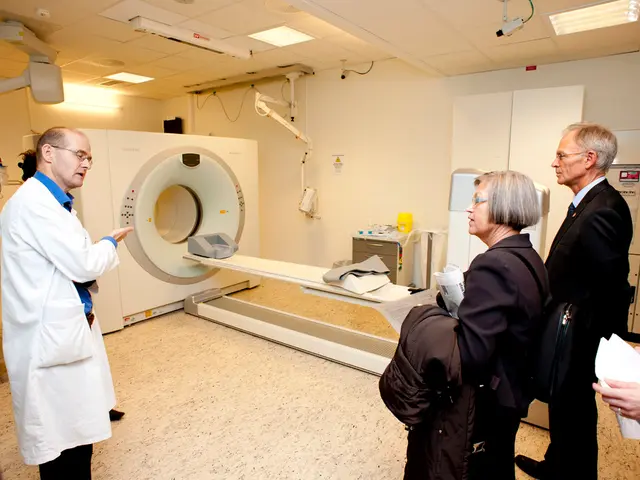Distinguishing Shingles from Herpes: Guidelines for Recognition
Understanding Shingles and Herpes: Key Differences and Similarities
Shingles and herpes are two common viral infections that affect millions of people worldwide. Although they share some similarities, there are key differences between the two conditions.
Causes and Primary Infections
Shingles, also known as herpes zoster, is caused by the reactivation of the varicella-zoster virus (VZV), the same virus that causes chickenpox. After a person has had chickenpox, the virus remains dormant in nerve ganglia and can reactivate later, especially in older adults or those with weakened immune systems [1][2][4]. On the other hand, herpes is caused by infection with two distinct viruses: HSV-1 and HSV-2. HSV-1 commonly causes oral herpes (cold sores), and HSV-2 typically causes genital herpes, though either virus can infect either site. Herpes viruses are transmitted through direct contact, most often sexual contact [5].
Symptoms
Shingles typically presents as a painful, blistering rash localized in a band or stripe along a sensory nerve (dermatome). Before rash onset, there is often burning or tingling pain in the affected area. The rash usually develops into fluid-filled blisters accompanied by sensitivity and possible fever or headaches. The pain can be severe and may persist as postherpetic neuralgia [2][4]. In contrast, herpes simplex infections cause painful sores or blisters localized at the site of infection (commonly mouth or genitals). Outbreaks are recurrent, and symptoms may include itching, burning, and sometimes flu-like symptoms during initial episodes [5].
Treatment
Both shingles and herpes are treated with antiviral medications, such as valacyclovir, which reduce the severity and duration of outbreaks if started early (ideally within 72 hours for shingles). There is no cure for either condition, but antiviral therapy helps manage symptoms and reduce complications [2][5]. Shingles vaccines (e.g., the recombinant zoster vaccine, Shingrix) are available to reduce the risk of shingles and its complications, especially recommended for older adults [1][2]. There is no vaccine for HSV herpes infections currently widely used for prevention [5].
Summary
In essence, shingles is a reactivation disease from the chickenpox virus, causing a localized painful rash usually in older or immunocompromised people, whereas herpes simplex virus causes recurrent sores primarily in oral or genital areas, transmitted by direct contact [1][2][4][5]. The rash associated with herpes typically breaks and results in painful sores. Treatment for both conditions generally involves antiviral medication, with the prescribed medications being acyclovir, famciclovir, and valacyclovir. It is possible for a person to develop HSV and shingles at the same time, although this is rare.
References:
[1] Centers for Disease Control and Prevention. (2021). Shingles. Retrieved from https://www.cdc.gov/shingles/about/index.html
[2] National Institute of Neurological Disorders and Stroke. (2021). Shingles Fact Sheet. Retrieved from https://www.ninds.nih.gov/Disorders/Patient-Caregiver-Education/Fact-Sheets/Shingles-Fact-Sheet
[4] World Health Organization. (2021). Shingles. Retrieved from https://www.who.int/news-room/fact-sheets/detail/shingles
[5] American Academy of Dermatology. (2021). Herpes. Retrieved from https://www.aad.org/public/diseases/contagious-skin-diseases/genital-herpes
- The varicella-zoster virus, responsible for both chickenpox and shingles, remains dormant in nerve ganglia, a type of skin-care concern that can reactivate later in life.
- Atopic dermatitis, a common form of eczema, is not related to herpes or shingles but sharing similarities with other medical-conditions of the skin such as psoriasis.
- In the realm of health and wellness, it is essential to remember that depression can have adverse effects on the overall health of an individual, including exacerbating the symptoms of shingles.
- The recombinant zoster vaccine, such as Shingrix, offers protection against shingles and its potential complications, making it a vital tool in the predictive armamentarium of COPD patients for health care.
- Sexual health encompasses more than just the prevention of sexually transmitted infections (STIs), it also includes the importance of refraining from direct contact to avoid contracting herpes from another individual.
- Skin care should be proactive, meaning regular checkups and monitoring for potential signs of skin-related medical conditions, whether it be shingles, herpes, or other ailments such as diabetes.
- Understanding the differences between shingles and herpes is crucial in the scientific community to enhance the advancement of medical-conditions treatments and "cure"-seeking research.
- For individuals with diabetes, there is an increased risk of developing shingles due to the suppression of the immune system; therefore, addressing diabetes should be integral in any health strategy.
- The sensorial nerve (tier) of the body plays a pivotal role in coordinating the development of the shingles rash, as the infection occurs predominantly along this network.
- It is important to note that even though both shingles and atopic dermatitis involve the skin, they are distinct medical-conditions that require unique approaches and treatments, reflecting the intricacies of the science behind health matters.








